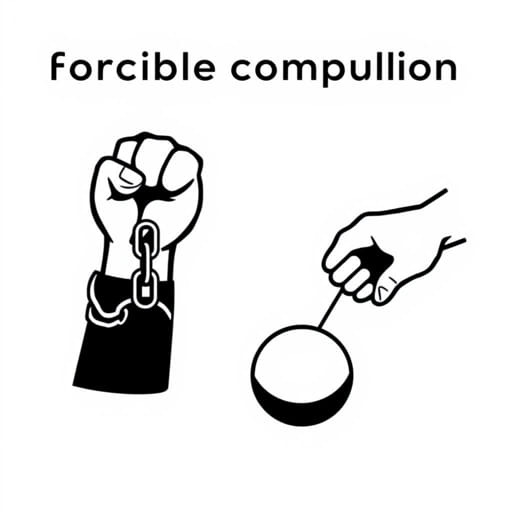In the realm of criminal law, forcible compulsion is a critical term used to describe the act of using physical force or threats to compel someone to do something against their will. It is often associated with serious criminal offenses, especially those involving personal violence or sexual assault. The concept is rooted in the protection of personal autonomy and freedom, ensuring individuals are not coerced or manipulated into actions through fear, intimidation, or violence. Understanding real-world examples of forcible compulsion helps illuminate how the legal system identifies and prosecutes such behaviors, reinforcing public safety and human rights.
Understanding Forcible Compulsion
Legal Definition and Scope
Forcible compulsion is defined in many legal systems as the use of physical force or the express or implied threat of immediate physical harm to compel someone into a particular action. The force or threat must be sufficient to overcome a person’s will, making them perform an act they would not have done voluntarily. In most jurisdictions, it is a key element in crimes like rape, kidnapping, robbery, and extortion.
Key Elements of Forcible Compulsion
- Physical Force: Actual physical contact or violence used to subdue or overpower the victim.
- Threat of Violence: Verbal or non-verbal threats that instill immediate fear of harm in the victim.
- Lack of Consent: The victim is forced to act without giving free and voluntary agreement.
Examples of Forcible Compulsion in Criminal Law
1. Sexual Assault Under Threat
One of the most common examples of forcible compulsion is in cases of sexual assault. A perpetrator may threaten to hurt the victim or their family unless they comply with sexual demands. Even if no physical force is used, the fear created by the threat is sufficient to nullify consent. Courts often classify such incidents as rape under the law of forcible compulsion.
2. Armed Robbery
In an armed robbery scenario, a criminal may point a weapon at a store clerk and demand money. The use of a gun, even if not fired, constitutes a threat of deadly force. The clerk’s compliance is not considered voluntary, as it is done under the fear of being shot. This is a clear case where the victim acts under forcible compulsion.
3. Domestic Violence and Control
In certain domestic violence situations, a partner may physically assault or threaten the other into submission. For example, forcing a spouse to stay home or perform certain actions through intimidation or beatings is considered forcible compulsion. The law protects victims by recognizing their lack of free will in such circumstances.
4. Kidnapping and Forced Movement
When a person is abducted and moved from one location to another against their will, the act is often accomplished through forcible compulsion. The use of physical restraint, binding, or threats to prevent escape all qualify as components of this legal definition. The offender’s intention to dominate the victim’s freedom plays a central role.
5. Extortion with Implied Threats
Not all cases involve overt violence. In extortion, threats can be subtle yet powerful enough to compel action. For instance, someone might threaten to release damaging personal information unless a payment is made. Though not physically violent, the implied threat can generate enough fear to be categorized as forcible compulsion in some legal systems.
Forcible Compulsion in Court Cases
How Prosecutors Use Evidence
In prosecuting crimes involving forcible compulsion, evidence is crucial. This can include:
- Testimonies from the victim and witnesses
- Medical reports showing signs of struggle or injury
- Audio or video recordings capturing threats or violence
- Physical evidence like weapons or bruises
Courts will assess whether the victim reasonably feared for their safety and whether that fear caused them to act against their will.
Challenges in Proving Forcible Compulsion
Proving forcible compulsion can be complex. The prosecution must establish that the victim was truly under duress and did not consent voluntarily. In some cases, especially those lacking physical evidence, the trial may hinge on the credibility of the victim’s testimony. Defense attorneys might argue that the victim acted willingly or that there was no real threat of harm.
Impact of Forcible Compulsion on Victims
Psychological Trauma
Victims of crimes involving forcible compulsion often suffer long-lasting psychological effects, including anxiety, depression, post-traumatic stress disorder (PTSD), and fear of recurrence. Their autonomy has been violated, leaving emotional scars that may take years to heal.
Legal Protections and Support
Most legal systems provide resources and protections for victims of forcible compulsion, such as restraining orders, victim advocacy services, counseling, and safe housing. Victims are encouraged to report incidents immediately and seek legal assistance to ensure their rights are protected and perpetrators are held accountable.
Preventing Forcible Compulsion
Legal Education and Awareness
Preventing crimes involving forcible compulsion requires public awareness about legal definitions and protections. Educational programs can empower people to recognize coercion, speak out, and seek help. Understanding one’s rights is the first step toward reducing vulnerability to such crimes.
Law Enforcement and Community Involvement
Effective law enforcement is essential in combating forcible compulsion. Police officers must be trained to identify signs of coercion and respond promptly. Communities should also play a role in supporting victims and reporting suspicious behavior, especially in domestic settings where compulsion may go unnoticed.
Examples of forcible compulsion are found throughout the legal landscape, from violent assaults to subtle threats that override a person’s will. Recognizing these acts is critical in ensuring justice and protecting individual freedom. By understanding the forms and consequences of such compulsion, society can better support victims and deter offenders. Forcible compulsion is not merely a legal term it represents a serious violation of human dignity that deserves strong legal and social response.
